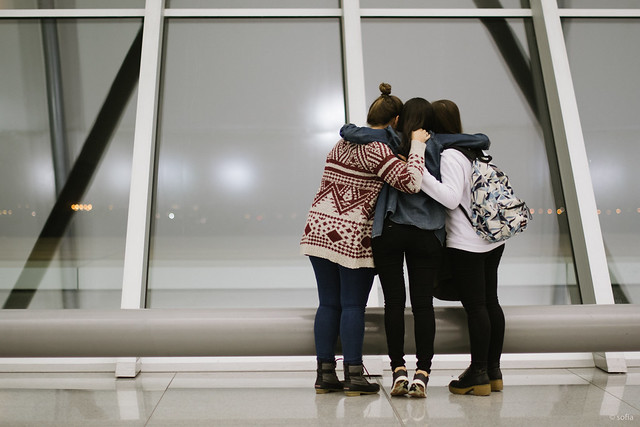April 10, 2018
How to say “beautiful” in Chamorro?

“Beautiful” in Chamorro
When saying that someone is beautiful, you would say bunita for females and bunitu for males.
bunita
beautiful, pretty, lovely
bunitu
handsome
NOTE: The word bunitu , from Spanish bonito, is often used as a general term to describe things as beautiful or pretty. When saying that a performance or movie was great or nice, it is often referred to as being bunitu. Chamorro musician K.C. DeLeon Guerrero’s sings how the day is beautiful in his song Bonito na Ha’ane.
Usage examples:
Bunita na palao’an si Maria.
Maria is a beautiful lady.
Bunitu na movie i Braveheart.
Braveheart is a good movie.
Bunitu magagu-ña si Denise.
Denise has pretty clothes.
“You’re beautiful” in Chamorro
Bunita hao.
You are pretty.
Bunita hao na palao’an.
You’re a pretty woman.
Bunita si Maria.
Maria is pretty.
Gof bunita hao.
You’re very pretty.
Na buninita hao.
You’re so pretty.
When describing places or settings, you can also use gefpå’go, which means the same thing as bunitu. The word itself tends to be used to describe places and things.
Gefpå’go na tåno’ iya Sweden.
Sweden is such a beautiful land.
Ya-hu iya Hawaii, sa’ gefpå’go na lugat.
I like Hawaii, because it is a beautiful place.
Gefpå’go mampos i tinige’-ña si Dolores.
Dolores’s writing is too beautiful.
Gefpå’go na lugåt iya Hawaii.
Hawaii is a beautiful place.
The word atånon means good-looking or attractive. The word is rooted in the word atan, meaning “to look”, and the suffix -on, meaning “to be capable of”. So literally, the word atånon means “capable of being looked at”, implying that something or someone is “pleasing to the eye.”
Atånon na taotao si Juan.
Juan is a good-looking man.
March 27, 2018
Chamorro Words and Common Phrases
While English is spoken throughout the Mariana Islands, it doesn’t hurt to know some common words and phrases beyond just saying hello. Below is a list of common, but useful words and phrases.
Common Phrases in Chamorro
| English | Chamorro | Pronunciation |
| Good morning. | Buenas dias. | BooEHN-as DEE-as |
| Good afternoon. | Buenas tåtdes. | BooEHN-as TAWT-dis |
| Good evening/Good night. | Buenas noches. | BooEHN-as NOH-tsis |
| Hello, my name is John. | Håfa adai, i na’ån-hu si John. | HAW-fah ee nah-AHN-hoo see John |
| What is your name? | Håyi, na’ån-mu? | HAWD-zee nah-AHN-moo |
| How are you? | Håfa tatatmanu hao? | HAW-fah tah-tat-ma-noo how |
| I am fine. | Mamaolek ha’ yu’. | MAH-mau-lick HA dzoo |
| Goodbye. | Adios. | ah-dee-OHS |
| Please. | Pot fabot. | put fah-boht |
| Thank you. | Si Yu’us ma’åse’. | see DZOO-oos mah-AW-see |
| I’m sorry. | Dispensa yu’. | diss-pen-sah dzoo |
| You are welcome. | Buen prubechu. | boo-EHN proo-beh-choo |
| You are welcome (it was nothing). | Tåya’ guaha. | TAWD-zah gwah-ha |
| How much does it cost? | Kuånto bali-ña? | koo-ahn-too bah-LEEN-yah |
| How much is this? | Kuånto este? | koo-ahn-too EHS-tee |
| How many are there? | Kuanto guaha? | koo-ahn-too gwah-ha |
| What time is it? | Ki ora? | KEE oh-ra |
| How do you say maybe in Chamorro? | Taimanu un sangan maybe gi fino’ Chamoru? | TIE-mah-noo OON saw-ngan maybe gee fee-noh tsah-moh-roo |
| Yes. | Hunggan. | HOONG-gan |
| No. | Åhe’. | AW-hee |
| I do not understand. | Ti hu komprende. | tee hoo kohm-pren-dee |
| I do not know. | Ti hu tungo’. | tee hoo toong-ooh |
| Who? | Håyi? | hawd-zee |
| Why? | Sa’ håfa? | SAH HAW-fah |
| Can you help me? | Kao siña un ayuda yo’? | kah-oo seen-ya oon ahd-zoo-dah dzoo |
| Where is ____? | Månu na gaige ____? | MAW-noo nah gai-geeh _____? |
Common Vocabulary Words
Places – Lugåt
| plåsan båtkon aire airport bångko bank guma’ Yu’us church fakteria factory hatdin garden ofisina office | metkao market espitåt hospital school eskuela resturan restaurant tenda store låncho ranch |
Body – I Tataotao
| ulu head gapotulu hair fåsu face talanga ear tuyan abdomen, belly | måta eyes gui’eng nose påchot mouth nifen teeth hand kånnai |
Animals – Gå’ga’
| katu cat ga’lågu dog guihan fish halu’u shark | paluma bird guaka cow månnok chicken haggan turtle |
May 16, 2017
How to say “Goodbye” in Chamorro

Goodbye is one of the most common expressions used in most languages, and here we present to you the multitude of ways of saying goodbye to someone in Chamorro.
Adios
Goodbye
The Chamorro adios is a direct loan from the Spanish adiós. This is probably what a native speaker would say if you asked how to say “goodbye” in Chamorro. What Chamorro speakers actually use is a different story. Use adios if there’s a sense of finality. You won’t be seeing someone for a while or for a long time. This is something you would say to acquaintances, people you respect or even family members who have traveled a long distance to visit you and are now returning home. What most people will use in place of adios on a daily basis follow.
Informal ways of saying goodbye
Esta
Alright then.
Oftentimes, this will be what you will hear. Between friends or people you know well, you say esta to indicate that you’re ending the conversation or meeting. It’s understood that you’ll most likely be seeing each other again.
Hågu ha’ / Hamyo ha’
Just you / Just you all
This is a statement made to let them know that you are leaving them. It’s a shortened form of saying “(It will now only be) just you (since I am leaving.)” The first form (hågu ha’) is if you are addressing only one person and the second (hamyo ha’) if you are addressing more than one.
Tatatte
I leave you behind.
Usually said in situations where there is some activity going on, and to avoid disruption you dismiss yourself by saying that you will leave everyone to it. It is rooted in the word tatte, which means ‘back, behind’.
Fanatatte
I leave you (all) behind.
(Used in the same way as the phrase above but addressing two or more people.)
Other ways of saying goodbye
Asta i despues
Until later, See you later
Asta agupa’
Until tomorrow, See you tomorrow
Asta lamo’na
Until tonight, See you tonight
Asta otro biahe
Until next time, See you next time
Asta i birada
Until the return, See you on the way back
Asta ki umali’e’ hit ta’lo
Until we meet again (singular)
Asta ki manali’e’ hit ta’lo
Until we all meet again (plural, addressing two or more people)
Asta ki…
Until then…
Asta i Lunes
Until Monday, See you Monday
Other Related Words
despidi
To say goodbye to someone, to bid farewell
Example:
Bai hu despidi si Francine, sa’ para u hanao tatte para California agupa’.
I will say goodbye to Francine, because she’s going back to California tomorrow.
despidida
A farewell, a goodbye.
This can refer to the act itself or a celebration, a farewell party.
May 15, 2017
How to say “Thank You” in Chamorro

There are a few ways to say thank you in Chamorro!
Si Yu’os ma’åse’
This the most common way to say “thank you” in Chamorro. The phrase itself differs from that of its English counterpart. What the phrase is really doing is asking God to be merciful to the person providing the service or gift. Si Yu’us (“God”, from Spanish Dios) ma’åse’ (“be merciful”).
Dångkulu na si Yu’us ma’åse’
Literally “a big thank you”, it is how you express “thank you very much” in Chamorro.
Other Useful Expressions
Si Yu’us ma’åse’ para i ayudu-mu (på’go).
Thanks for your help (today).
Buen prubechu
You’re welcome (formal)
Tåya’ guaha
You’re welcome (casual)
Gracias adios!
Thank God! Thank goodness! Thank heavens!
Other Ways to Say Thank You
A resurgence in Chamorro pride and identity has led specific groups of Chamorro speakers to begin suppressing and replacing the Spanish words and phrases in Chamorro in favor of indigenous Chamorro words. This has led to the expression saina ma’å’se’ in favor of si Yu’us ma’åse’. The word saina is the indigenous word for “elder” and can also be heard in the word asaina, a reference to God.
Whichever you decide to say, the important thing is that you say it. Being courteous in any language goes a long way to earning respect and friendship.
Now that you’ve learned how to say “thank you”, you should learn more ways to say “you’re welcome”.
May 14, 2017
How to say “I love you” in Chamorro

Traditionally, to say “I love you” in Chamorro or even to just generally express your love for someone has always been confined to intimate situations or occasions. However, as Chamorros have become more exposed to American media and culture, it’s become more common to hear in daily life.
How to say “I love you” in Chamorro
Hu guaiya håo
“Hu guaiya hao”, literally means “I love you” and is the most common way to express your love for someone in Chamorro. The word guaiya is the verb for “to love” and can be used in more than one way as can be seen in the next expression.
Mangguaiya yo’ nu hågu
This also tells someone that you love them but the understanding is a little different. You can use this expression to tell family or friends that you love them, BUT if you say this to someone you are dating or in a romantic relationship with, you are telling them that you are “in love” with them.
Other “Love” Phrases
Hu guaiya håo lokkue’.
I love you too.
Hu guaiya håo para siempre.
I love you forever.
I guinaiya-ku.
My love.
Hågu i guinaya-ku.
You are my love.
Examples in Chamorro Music
The following are examples of Chamorro songs that express “I love you” in Chamorro. The first song is Johnny Sablan’s U Guaiya Hao, which here the hu is written colloquial style. The second song is Hågu i Rason i Lina’lå’-hu, “you are the reason for my life”, by KC Deleon Guerrero.
Cover of song Hu Guaiya Hao by Johnny Sablan.
The song Hagu i Rason i Lina’la’-hu by KC Deleon Guerrero.
Other Ways to Express Your Love
While actually using the word “love” is the most common way in most languages, there are other expressions that also accomplish the same thing.
Hågu i Rason i Lina’lå’-hu
Like the song says, you are the reason I exist, the reason I wake up every morning. With a sentiment like that, you’d probably follow this up with the next phrase.
Tåya’ yo’ sin hågu
“I am nothing without you”, so do I need to say more?
Have an expression of love you’d like to share? Email webmagas@chamoru.info!
